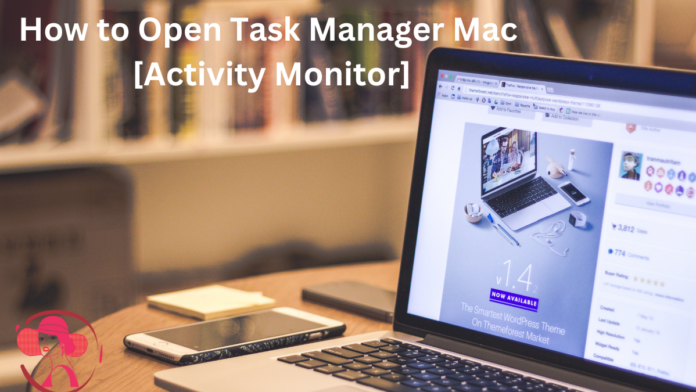Task Manager Mac is known as Activity Monitor. It serves a similar purpose to the Task Manager on Windows, allowing users to monitor and manage system performance and processes.
This article will explain how to open Activity Monitor, detail its various functions, and provide tips on how to use it effectively to optimize your Mac’s performance.
What is an Activity Monitor?
Activity Monitor is a powerful utility with macOS that provides detailed information of the processes and applications running on your Mac.
It shows you which applications are using the most resources, helps you identify any issues affecting system performance, and lets you to force-quit unresponsive applications.
How to Open Activity Monitor?
There are several ways to open Activity Monitor on a Mac. Here are the most common methods:
Using Spotlight Search
Spotlight Search is the quickest way to open Activity Monitor.
- Press Command + Spacebar to open Spotlight Search.
- Type “Activity Monitor” into the search bar.
- Press Enter when Activity Monitor appears in the search results.
Using Finder
You can also open Activity Monitor through Finder.
- Click on the Finder icon in the Dock.
- Navigate to the Applications folder.
- Open the Utilities folder.
- Double-click on Activity Monitor to open it.
Using the Dock
If you frequently use Activity Monitor, you can add it to your Dock for easy access.
- Open Activity Monitor using one of the methods above.
- Right-click on the Activity Monitor icon in the Dock.
- Select Options.
- Click on Keep in Dock.
Understanding the Activity Monitor Interface
The Activity Monitor interface is divided into several tabs, each providing information about your system. Here is an overview of each tab and its functions:
CPU Tab
The CPU tab displays the processor usage of running applications and processes.
- % CPU: Shows the CPU capacity percentage used by each process.
- User: Displays CPU usage by user processes.
- System: Shows CPU usage by system processes.
- Idle: Indicates the percentage of CPU capacity that is not being used.
Memory Tab
The Memory tab features information about your Mac’s RAM usage.
- Memory Pressure: Visual indicator of the memory demand on your system.
- Physical Memory: Total RAM installed on your Mac.
- Memory Used: Amount of RAM currently in use.
- Cached Files: RAM used by recently closed apps, available for other apps if needed.
- Swap Used: Amount of disk space used for memory swapping when physical RAM is full.
Energy Tab
The Energy tab shows information about energy usage, helpful for managing battery life on portable Macs.
- Energy Impact: Measure of the energy consumption of each process.
- 12 hr Power: Average energy impact over the past 12 hours.
- App Nap: Indicates if an app is using the App Nap feature to save power.
Disk Tab
The Disk tab displays information about disk usage and activity.
- Bytes Read/Written: Amount of data read from or written to the disk by each process.
- Reads in: Number of read operations performed by each process.
- Writes out: Number of write operations performed by each process.
Network Tab
The Network tab shows information about network activity.
- Packets in/out: Number of data packets sent and received by each process.
- Data received/sent: Amount of data transferred by each process.
- Packets in/out total: Total number of packets sent and received.
Using Activity Monitor to Manage Your Mac
Activity Monitor can be a valuable tool for managing your Mac’s performance. Here are some tips on how to use it effectively:
Identifying Resource-Hungry Applications
To identify which applications use the most resources, look at the CPU and Memory tabs’ % CPU and Memory columns. Applications that use a high percentage of CPU or a large amount of RAM can slow down your Mac.
Force Quitting Applications
If an application becomes unresponsive, you can use Activity Monitor to force quit it.
- Select the application in the list.
- Click the X button in the upper-left corner of the Activity Monitor window.
- Confirm that you want to force quit the application.
Monitoring Memory Usage
Keep an eye on the Memory Pressure graph in the Memory tab. If the graph is consistently in the yellow or red, your Mac may not have enough RAM for the tasks you’re performing. Closing unnecessary applications can help reduce memory pressure.
Managing Energy Consumption
The Energy tab is useful for laptop users who need to manage battery life. Applications with high Energy Impact values can drain your battery quickly. Consider closing or limiting the use of these applications when running on battery power.
Checking Disk Activity
In the Disk tab, you can monitor disk activity to identify processes that heavily read from or write to the disk. High disk activity can slow down your system, especially when using an older Mac with a traditional hard drive.
Monitoring Network Activity
Use the Network tab to see which applications use the most bandwidth. This can be helpful if you’re experiencing slow internet speeds or need to manage data usage on a limited plan.
Advanced Features and Tips
Activity Monitor also includes some advanced features and tips for more experienced users:
- To access more detailed diagnostics, click the View menu and select “System Diagnostics.” This will generate a report with detailed information about your system’s performance and health.
- You can customize the columns in Activity Monitor to show the most relevant information.
- Right-click on any column header.
- Select the columns you want to add or remove.
- For advanced users, Activity Monitor can be used with Terminal to monitor and manage processes.
- To open a Terminal window for a specific process, select the process in Activity Monitor, then go to the View menu and select “Open Files and Ports.” This will open a Terminal window showing detailed information about the process’s files and ports.
Common Issues and Troubleshooting
Sometimes, you may encounter issues while using Activity Monitor or notice unusual behaviour on your Mac. Here are some common issues and troubleshooting tips:
High CPU Usage
If you notice high CPU usage, it could be due to a specific application or process. Use Activity Monitor to identify the culprit and consider quitting or restarting the application. If the issue persists, you may need to restart your Mac.
Memory Leaks
A memory leak occurs when an application continuously uses more memory without releasing it. This can slow down your Mac over time. If you suspect a memory leak, use Activity Monitor to identify and restart the application. Updating the application to the latest version can also help.
Slow Performance
If your Mac is running slowly, use Activity Monitor to check for applications or processes using a lot of CPU or memory. Closing unnecessary applications and restarting your Mac can help improve performance.
Excessive Disk Activity
High disk activity can slow down your Mac, especially if you have a traditional hard drive. Use the Disk tab in Activity Monitor to identify the processes causing high disk activity and consider quitting or optimizing those applications.
Conclusion
Activity Monitor is a powerful tool that provides valuable insights into your Mac’s performance. By understanding how to use it effectively, you can manage resources, identify and resolve issues, and optimize your Mac for better performance. Whether you’re a casual user or a seasoned pro, Activity Monitor is an essential utility for maintaining the health and efficiency of your Mac.
FAQs
What is Task Manager Mac?
Task Manager Mac is a utility that provides detailed information about the steps and applications running on your Mac. It allows you to monitor system performance and manage resources.
How do I open Activity Monitor on my Mac?
You can open Activity Monitor using Spotlight Search, Finder, or by adding it to your Dock for easy access.
What can I do with Activity Monitor?
Activity Monitor allows you to monitor CPU, memory, energy, disk, and network usage, identify resource-hungry applications, and force quit unresponsive applications.
How can I use Activity Monitor to improve my Mac’s performance?
Use Activity Monitor to identify and manage applications that are using excessive resources, monitor memory usage, manage energy consumption, and check disk and network activity to optimize your Mac’s performance.















